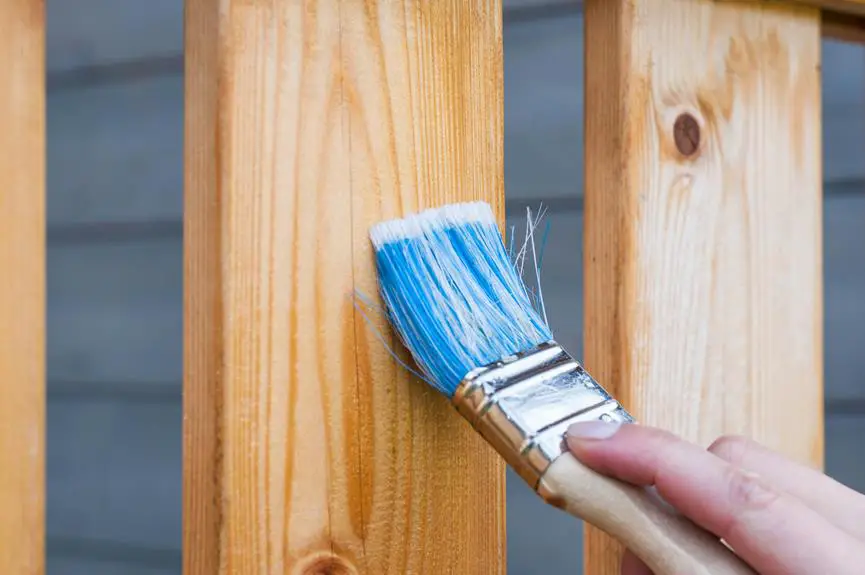When you assess your fabric for damage, you might notice tears or frays that compromise its integrity. It's essential to gather the right tools, like fabric scissors and a sturdy needle, to ensure effective repairs. By employing techniques such as stitching or patching, you can not only restore the fabric's appearance but also enhance its protection. However, understanding how to maintain and prevent future wear is just as crucial. So, what are the best practices to ensure your fabrics stand the test of time?
Table of Contents
Key Takeaways
- Assess fabric damage by inspecting for tears, frays, and discoloration to determine appropriate repair methods.
- Use high-quality materials like matching thread and sturdy needles to ensure durable repairs.
- Employ mending techniques such as stitching frayed edges or patching holes with suitable fabric types and colors.
- Restore color vibrancy by using color-safe detergents and applying UV protectants to minimize fading.
Assessing Fabric Damage
You'll often find that assessing fabric damage is the first crucial step in determining the best repair method. Start by examining the fabric closely; look for tears, frays, or discoloration. Pay attention to the fabric type, as different materials may require unique approaches. If you spot a tear, measure its size. A small tear might be easily stitched, while larger ones may need patching or more advanced techniques.
Next, check the surrounding area for any signs of wear. Often, damage can spread if not addressed promptly. You'll want to assess how deep the damage goes; superficial issues are usually less complicated to repair. Don't forget to consider the fabric's overall condition. If the fabric is fragile or extensively worn, you might need to rethink your repair strategy.
Also, take note of how the fabric was originally finished. Some fabrics have special treatments that could affect the repair process. By gathering all this information, you'll be better equipped to choose the right repair method and materials later on. Ultimately, a thorough assessment ensures a more effective and lasting repair, saving you time and effort in the long run.
Tools and Materials Needed
To effectively repair fabrics, you'll need a few essential tools and materials at your disposal.
First, gather a good pair of fabric scissors; these will help you cut through any damaged areas cleanly. You'll also want a seam ripper for removing any unwanted stitches without damaging the surrounding fabric.
Next, invest in high-quality thread that matches your fabric. It's crucial for creating a seamless repair. A sturdy needle is also a must; choose one that suits the thickness of your fabric. If you're working with heavier materials, consider a denim or upholstery needle.
Additionally, keep a fabric adhesive or fusible tape handy for quick fixes. These can provide instant support without the need for sewing.
Don't forget to grab some pins or clips to hold your fabric in place while you work.
Mending Frayed Edges
Mending frayed edges requires careful attention to detail to restore the fabric's integrity and appearance. Start by identifying the frayed area and trimming any loose threads. Use sharp scissors for a clean cut, ensuring you don't damage the surrounding fabric. Next, choose a suitable thread color that matches your fabric for a seamless finish.
Here's a quick guide to help you get started:
| Step | Details |
|---|---|
| Trim Loose Threads | Carefully cut away any frayed or loose threads. |
| Choose Thread | Select a thread color that matches your fabric. |
| Use a Needle | Thread a needle and knot the end of the thread. |
Now you can begin stitching. Use a simple straight stitch or a zigzag stitch to secure the frayed edges. Make sure to sew closely to the edge, but avoid pulling too tightly to prevent puckering. Once you've completed the stitching, tie off the thread securely and trim any excess. Your fabric will now look neater and more durable, ready for continued use!
Patching Holes Effectively
When you're patching holes, it's crucial to choose the right patch for your fabric type.
Preparing the fabric properly will set the stage for a successful repair.
Understanding various stitching techniques can make all the difference.
Let's explore these essential points to ensure your patches not only fix the holes but also blend seamlessly with your fabric.
Choosing the Right Patch
Choosing the right patch can significantly enhance the durability and appearance of your repaired fabric.
First, consider the fabric type. Different materials, like denim or cotton, require specific patches that blend in seamlessly. For heavier fabrics, opt for a thicker patch; for lighter ones, a thinner patch will suffice.
Next, think about the patch's color and pattern. You want it to either match the fabric or create a stylish contrast. If you're patching a favorite shirt, choose a fabric that complements its existing colors. This way, your repair looks intentional rather than haphazard.
Also, pay attention to the adhesive used. Iron-on patches are great for quick fixes, but for items that undergo a lot of wear, sewing the patch on might be more effective. Ensure the adhesive is strong enough to withstand washing and wearing.
Preparing the Fabric
Before you start patching holes, make sure to clean and prepare the fabric to ensure a strong, lasting repair.
Begin by inspecting the area around the hole for any fraying or loose threads. Trim away any damaged fabric carefully, as this will help you create a clean surface for the patch.
Next, wash the fabric according to its care label instructions. This removes dirt, oils, and any previous stains that could interfere with the adhesive or stitching. If the fabric is particularly delicate, consider handwashing it to avoid further damage. After washing, let it dry completely.
Once the fabric is dry, press it with an iron to eliminate wrinkles. This step is crucial, as a flat surface helps your patch adhere better and makes your repair look more professional. If you're working with a fabric that tends to fray, you can apply a light fray check solution around the edges of the hole.
Lastly, lay the fabric flat on a clean, stable surface to ensure you have a good foundation for applying your patch.
With everything prepped, you're ready to move on to the stitching techniques that will secure your patch effectively.
Stitching Techniques Explained
Now that you've prepared the fabric, it's time to explore various stitching techniques that will ensure your patch stays securely in place.
When you're patching holes, using the right stitches can make all the difference in durability and appearance. Here are four effective stitching techniques to consider:
- Straight Stitch: This simple technique works well for small holes. Just run your needle in and out, keeping your stitches even and close together.
- Zigzag Stitch: Ideal for frayed edges, this stitch helps prevent further unraveling. It gives a flexible hold while securing the patch.
- Blind Stitch: If you want a neat finish, this technique hides the stitches on the back of the fabric. It's perfect for delicate materials where you want to maintain a clean look.
- Cross Stitch: For a decorative touch, use cross stitches to secure your patch. This not only reinforces the area but adds a unique element to your repair.
Restoring Color and Vibrancy
When your fabrics start to lose their color, it can be frustrating, but understanding the causes of color fading is the first step to restoration.
You'll discover various techniques to bring back vibrancy and learn maintenance tips to keep your fabrics looking fresh longer.
Let's explore how to revive your beloved items effectively.
Color-Fading Causes
Understanding the causes of color fading is essential for restoring your fabrics' vibrancy and extending their life. When you know what leads to color loss, you can take steps to protect your items more effectively. Here are some common culprits:
- Sunlight Exposure: Prolonged exposure to UV rays can bleach your fabrics, leading to dull colors over time.
- Washing Methods: Using harsh detergents or hot water can strip away color. Always check care labels for the best washing practices.
- Chemical Reactions: Certain chemicals, like bleach or even some cleaning agents, can cause colors to fade or become discolored.
- Wear and Tear: Regular use, along with friction and abrasion, can wear down the fibers, resulting in a faded appearance.
Restoration Techniques
To restore color and vibrancy in your fabrics, it's important to employ effective techniques that counteract the effects of fading caused by environmental factors and wear.
Start by washing your fabrics with a gentle detergent specifically designed for colors. This helps lift dirt without stripping the dye. After washing, consider using a color-safe fabric restorer or dye. These products come in various shades and can revitalize your fabric's original hue.
If you're dealing with a natural fabric, such as cotton or silk, you can also use a vinegar rinse. Mix one part vinegar with four parts water and soak the fabric for about 30 minutes. This solution can help restore vibrancy while also softening the fabric.
For synthetic fabrics, you might want to opt for a fabric spray that revitalizes color. Simply spray the affected areas and follow the instructions for best results.
Lastly, always remember to test any product on a small, inconspicuous area first. By taking these steps, you'll breathe new life into your faded fabrics, making them look vibrant and fresh once again.
Maintenance Tips
Regular maintenance is key to preserving the color and vibrancy of your fabrics, ensuring they stay fresh and appealing for years to come.
Here are some effective tips to help you maintain your fabrics' brilliance:
- Wash with Care: Always follow the care label instructions. Use cold water and mild detergents to prevent fading and shrinking.
- Avoid Direct Sunlight: When drying fabrics, keep them out of direct sunlight. UV rays can bleach colors, so opt for a shaded area instead.
- Use Color-Safe Products: Invest in color-safe detergents and fabric softeners. These products are specifically formulated to protect and enhance fabric colors.
- Store Properly: When not in use, store your fabrics in a cool, dry place. Use breathable bags and avoid plastic containers, as they can trap moisture and lead to discoloration.
Preventing Future Damage
Preventing future damage to fabrics requires vigilance and proactive care. Start by identifying potential threats to your fabrics, such as sunlight, spills, and pests. Keep your items away from direct sunlight to prevent fading and degradation. Use curtains or UV-protective covers to shield your fabrics from harsh rays.
Regularly inspect your fabrics for signs of wear or damage. Addressing small issues immediately can prevent larger problems down the line. When it comes to cleaning, always follow the care instructions. Use gentle detergents and avoid harsh chemicals that can weaken fibers.
Additionally, be mindful of how you store your fabrics. Use breathable storage bags and avoid overcrowding to prevent creasing and tearing. If you're storing items for long periods, consider using mothballs or cedar blocks to deter pests without damaging the fabric.
Lastly, make a habit of rotating your fabrics. This ensures that no single piece bears the brunt of wear and tear. By taking these steps, you'll not only protect your fabrics but also extend their lifespan, ensuring they remain beautiful and functional for years to come.
Maintenance Tips for Longevity
Taking care of your fabrics not only involves preventing damage but also includes implementing maintenance tips that promote longevity. By following these simple practices, you can keep your fabrics looking fresh and extend their lifespan.
- Regular Cleaning: Wash your fabrics according to their care labels. Use gentle cycles and avoid harsh detergents to prevent wear and tear.
- Proper Storage: Store your fabrics in a cool, dry place. Avoid damp areas that encourage mold and mildew. Use breathable garment bags for clothing and containers for linens.
- Rotate Use: If you have multiple similar items, rotate their usage. This helps distribute wear evenly, reducing stress on any one fabric.
- Avoid Direct Sunlight: Keep your fabrics away from direct sunlight when not in use. UV rays can fade colors and weaken fibers over time.
Frequently Asked Questions
Can I Repair Fabrics Without Sewing Skills?
Yes, you can repair fabrics without sewing skills! Try using fabric glue, iron-on patches, or fusible tape. These options are simple and effective, letting you fix tears and holes quickly without needing any sewing expertise.
What Types of Fabrics Are Easiest to Repair?
When you're looking to repair fabrics, cotton and denim are often the easiest. They handle adhesive patches well and can be stitched without much hassle, letting you tackle repairs confidently, even if you're a beginner.
How Do I Clean Fabric Before Repairing?
Before you repair fabric, start by cleaning it thoroughly. You should remove dirt and stains using a gentle detergent, then rinse well. Allow it to dry completely before proceeding with any repairs to ensure effective adhesion.
Are There Eco-Friendly Repair Options Available?
Yes, there are eco-friendly repair options available! You can use organic fabrics, natural dyes, and biodegradable adhesives. Upcycling old materials for patches or mending can also reduce waste while giving your repair a unique touch.
Can I Use Fabric Glue Instead of Sewing?
Yes, you can use fabric glue instead of sewing. It's quick and easy, especially for small repairs. Just ensure the fabric's clean, and apply the glue evenly for the best results. It'll hold well!
- Jaclyn Smith Fabric Coconut: a Review of This Rayon/Polyester Blend - June 29, 2025
- Jaclyn Smith Fabric Coconut: a Review of This Rayon/Polyester Blend - June 29, 2025
- How to Get Coconut Oil off Fabric Without Washing - June 29, 2025







